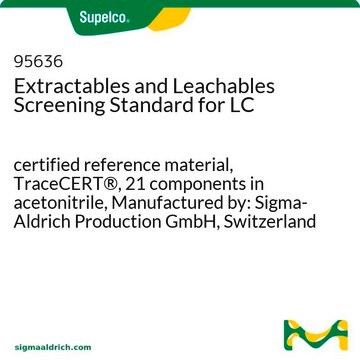Products may be shipped at a different temperature than the recommended long-term storage temperature. If the product quality is sensitive to short-term exposure to conditions other than the recommended long-term storage, it will be shipped on wet or dry-ice. If the product quality is NOT affected by short-term exposure to conditions other than the recommended long-term storage, it will be shipped at ambient temperature. As shipping routes are configured for minimum transit times, shipping at ambient temperature helps control shipping costs for our customers. For more information, please refer to the Storage and Transport Conditions document: https://www.sigmaaldrich.com/deepweb/assets/sigmaaldrich/marketing/global/documents/316/622/storage-transport-conditions-mk.pdf
650560
Terc-butilmetil éter
HPLC Plus, for HPLC, GC, and residue analysis, 99.9%
Sinónimos:
MTBE, Éter metil terc-butílico
About This Item
Productos recomendados
grado
HPLC Plus
Nivel de calidad
densidad de vapor
3.1 (vs air)
presión de vapor
4.05 psi
Ensayo
99.9%
Formulario
liquid
temp. de autoignición
705 °F
lim. expl.
15.1 %
técnicas
HPLC: suitable
gas chromatography (GC): suitable
impurezas
≤0.02% water
<1.0 ppb Fluorescence (quinine) at 365 nm
residuo de evap.
≤0.0001%
residuo halogenado
≤10 ng/L (as heptachlor epoxide)
índice de refracción
n20/D 1.369 (lit.)
bp
55-56 °C (lit.)
mp
-110 °C
densidad
0.74 g/mL at 25 °C (lit.)
λ
H2O reference
Absorción UV
λ: 210 nm Amax: 1.0
λ: 225 nm Amax: 0.50
λ: 250 nm Amax: 0.10
λ: 300-400 nm Amax: 0.005
idoneidad
suitable for residue analysis
aplicaciones
PFAS testing
food and beverages
cadena SMILES
COC(C)(C)C
InChI
1S/C5H12O/c1-5(2,3)6-4/h1-4H3
Clave InChI
BZLVMXJERCGZMT-UHFFFAOYSA-N
¿Está buscando productos similares? Visita Guía de comparación de productos
Categorías relacionadas
Descripción general
Aplicación
Envase
As a global leader in lab reagents, we are constantly looking for new ways to optimize the safety of our products. The newly developed 4L solvent bottle design features advanced sealing technology that eliminates leaks to make the handling of solvents safer and more convenient than ever before.
See all the new features here!
Otras notas
Información legal
Palabra de señalización
Danger
Frases de peligro
Consejos de prudencia
Clasificaciones de peligro
Flam. Liq. 2 - Skin Irrit. 2
Código de clase de almacenamiento
3 - Flammable liquids
Clase de riesgo para el agua (WGK)
WGK 1
Punto de inflamabilidad (°F)
-18.4 °F - closed cup
Punto de inflamabilidad (°C)
-28 °C - closed cup
Elija entre una de las versiones más recientes:
¿Ya tiene este producto?
Encuentre la documentación para los productos que ha comprado recientemente en la Biblioteca de documentos.
Los clientes también vieron
-
How is shipping temperature determined? And how is it related to the product storage temperature?
1 answer-
Helpful?
-
-
How can I determine the shelf life / expiration / retest date of this product?
1 answer-
If this product has an expiration or retest date, it will be shown on the Certificate of Analysis (COA, CofA). If there is no retest or expiration date listed on the product's COA, we do not have suitable stability data to determine a shelf life. For these products, the only date on the COA will be the release date; a retest, expiration, or use-by-date will not be displayed.
For all products, we recommend handling per defined conditions as printed in our product literature and website product descriptions. We recommend that products should be routinely inspected by customers to ensure they perform as expected.
For products without retest or expiration dates, our standard warranty of 1 year from the date of shipment is applicable.
For more information, please refer to the Product Dating Information document: https://www.sigmaaldrich.com/deepweb/assets/sigmaaldrich/marketing/global/documents/449/386/product-dating-information-mk.pdfHelpful?
-
Active Filters
Nuestro equipo de científicos tiene experiencia en todas las áreas de investigación: Ciencias de la vida, Ciencia de los materiales, Síntesis química, Cromatografía, Analítica y muchas otras.
Póngase en contacto con el Servicio técnico







